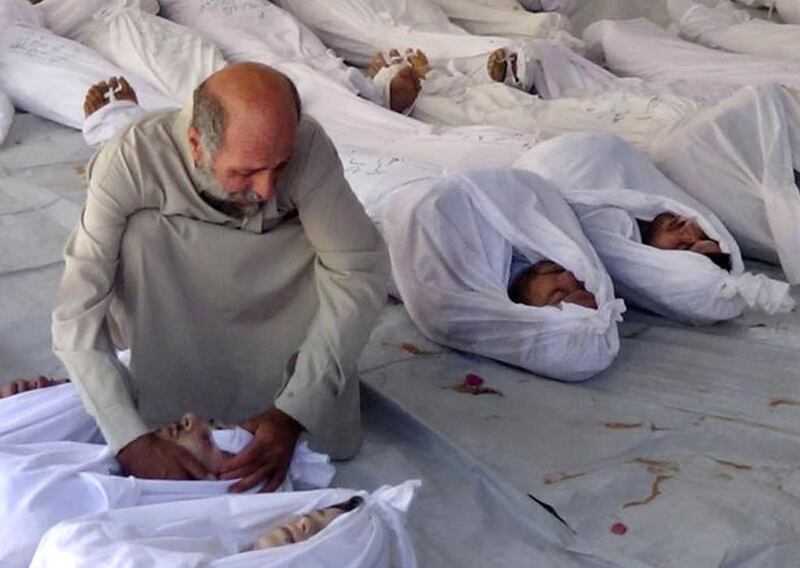ISTANBUL // There were ample warnings a doomsday scenario was unfolding in Syria and 2013 was the year in which the dire prophecies came true.
Conditions were already unspeakably bad by the start of the year — cities razed, tens of thousands killed, uncounted atrocities — but Syria’s descent continued apace as millions of displaced civilians sought refuge in neighbouring countries while the use of chemical weapons shocked the world.
At an international conference in Geneva in June the UN launched its largest ever humanitarian aid appeal to raise US$5.2 billion (Dh19bn) for medical supplies, clean water, refugee camps and basic food items for millions of people — for a country that once boasted of food self-sufficiency, it was a sign of how far the state had collapsed
Grizzled aid workers, who had worked wars and famines in Africa and Eastern Europe, described Syria as the most complicated, large-scale disaster they had ever seen. The word “apocalyptic” started to crop up in their descriptions.
In besieged, rebel-held suburbs of Damascus, reports emerged of people dying from starvation while the Syrian authorities denied access for aid agencies or food supplies.
UN human rights specialists kept pushing for war crimes prosecutions but, in the Security Council, the only UN body with the clout to take such action, deadlock continued, Russia blocking any meaningful resolutions critical of their ally Bashar Al Assad.
In his alliances, the Syrian president has been more astute or luckier than his opponents.
As the West equivocated over the rebellion, promising much but sending little to the emaciated moderate nationalists of the Free Syrian Army, Moscow and Tehran, the regime’s key backers, wrote multibillion cheques to help overcome western economic sanctions and to shore up Mr Al Assad’s battered armed forces.
More than political support, money or munitions, the Syrian regime also got boots on the ground from its allies.
Iran and Hizbollah — the Lebanese militant group that has sworn loyalty to Iran’s Supreme Leader — sent in thousands of seasoned guerrilla fighters to do battle in Mr Al Assad’s killing fields.
This cemented Syria’s status as a crucible for a wildly dangerous, proxy sectarian conflict, with Shiite militia groups, backed by Iran, fighting a bitter war against Sunni militants — and a growing Al Qaeda affiliated block — that drew both official and unofficial support from Arabian Gulf states.
Increasingly the war was fought and funded by non-Syrians, with the moderate, liberal activists who began protests back in the spring of 2011 — those who survived or avoided capture by the regime — watching in dismay at their peaceful revolution gone awry, sidelined in a battle ever more dominated by extremists.
Hizbollah fighters plus Iranian training for new militia units, helped turn the tide of a slow moving war back in Mr Al Assad’s favour.
Nonetheless, much of Syria remained a foreign land to the regime that had ruled it so unaccountably for so long. Areas of Damascus, a few kilometres from the presidential palace, were zones in which no regime security officer could set foot.
The need to reassert control over the rebellious outskirts of Damascus appears to have sparked the most notorious atrocity of the conflict. On August 21 hundreds of people were killed in poison gas attacks on the rebel held Ghouta, to the east and south-west of the capital.
A UN investigation confirmed what was the world’s largest chemical weapon strike since the 1980s but, because of the diplomatic stalemate in the Security Council, a team of UN experts dispatched to the Ghouta were not allowed to apportion blame.
Syria’s regime denied responsibility but the evidence of what was a large scale, complex attack, far beyond the capabilities of rebel bands, pointed overwhelmingly in their direction.
Briefly in the aftermath, American armed forces did seem on the brink of launching missile strikes against regime targets, only for an ad hoc, last-minute deal, whereby Syria would give up its chemical weapons, to avert intervention.
Mr Al Assad’s undoubted relief can only have been matched by that of US president Barack Obama, who, like a majority of the US public, wants no part in another war in the Middle East.
Indeed after almost three years of conflict, by the end of 2013 Washington, and Europe, have now moved closer to Moscow and Mr Al Assad — all more concerned about the growing power of Al Qaeda in Syria than the cruelty and injustice of the regime. That the regime’s violence, and the world’s inaction, were the major triggers for Al Qaeda’s rise is apparently of little importance in the calculus of realpolitik.
The fighting will continue in 2014 but a much delayed peace conference in Switzerland three weeks into the New Year offers some threadbare cause for hope.
But the conflict will not end until the regime and its backers, and the rebels and their supporters, have decided it must, and that point remains a long way off. Solutions to the underlying causes of Syria’s problems — political stagnation, corrupt one-family rule and a defunct economy — are even further distant, buried now beneath the rubble of Syrian cities.
psands@thenational.ae





